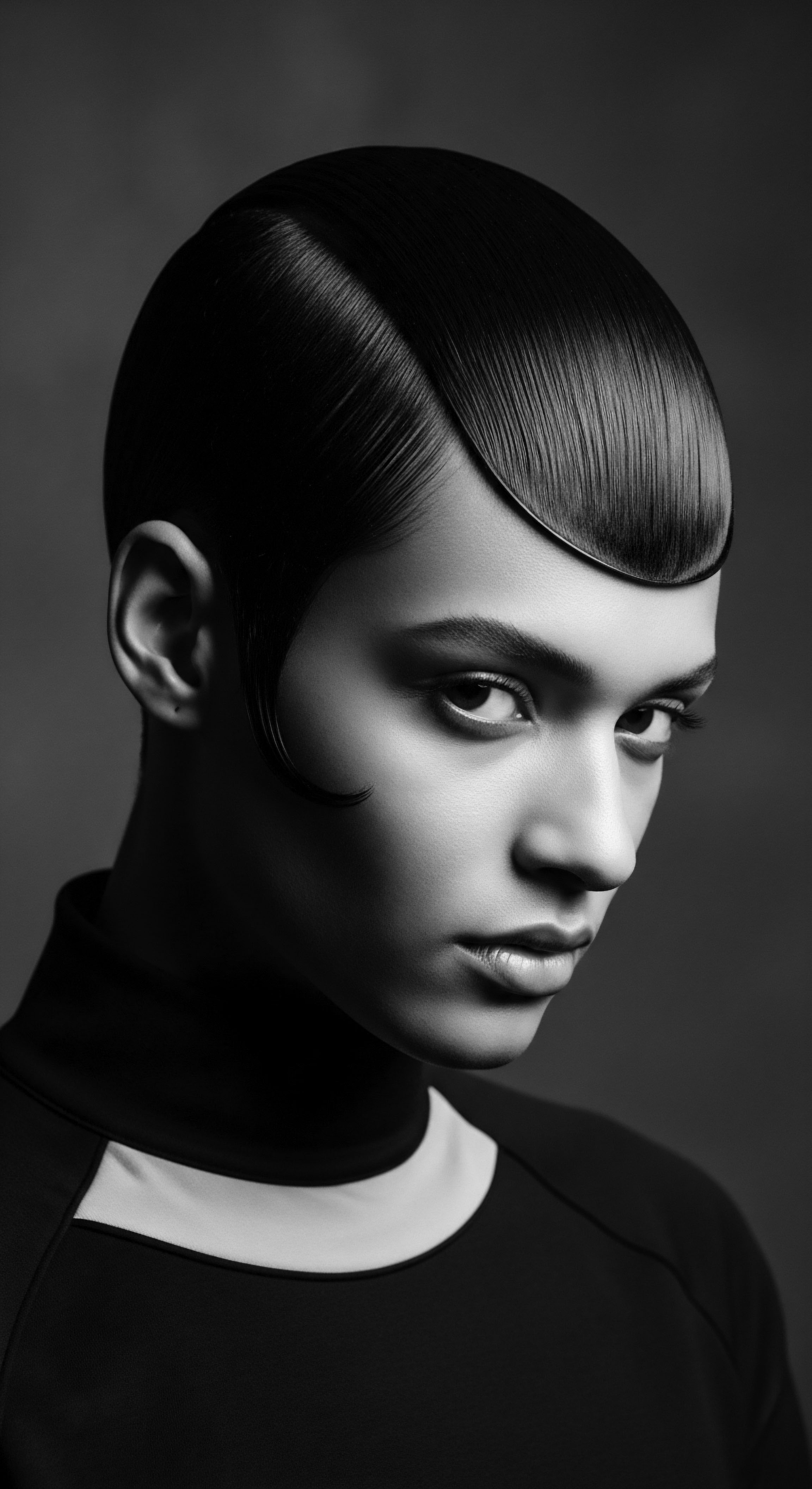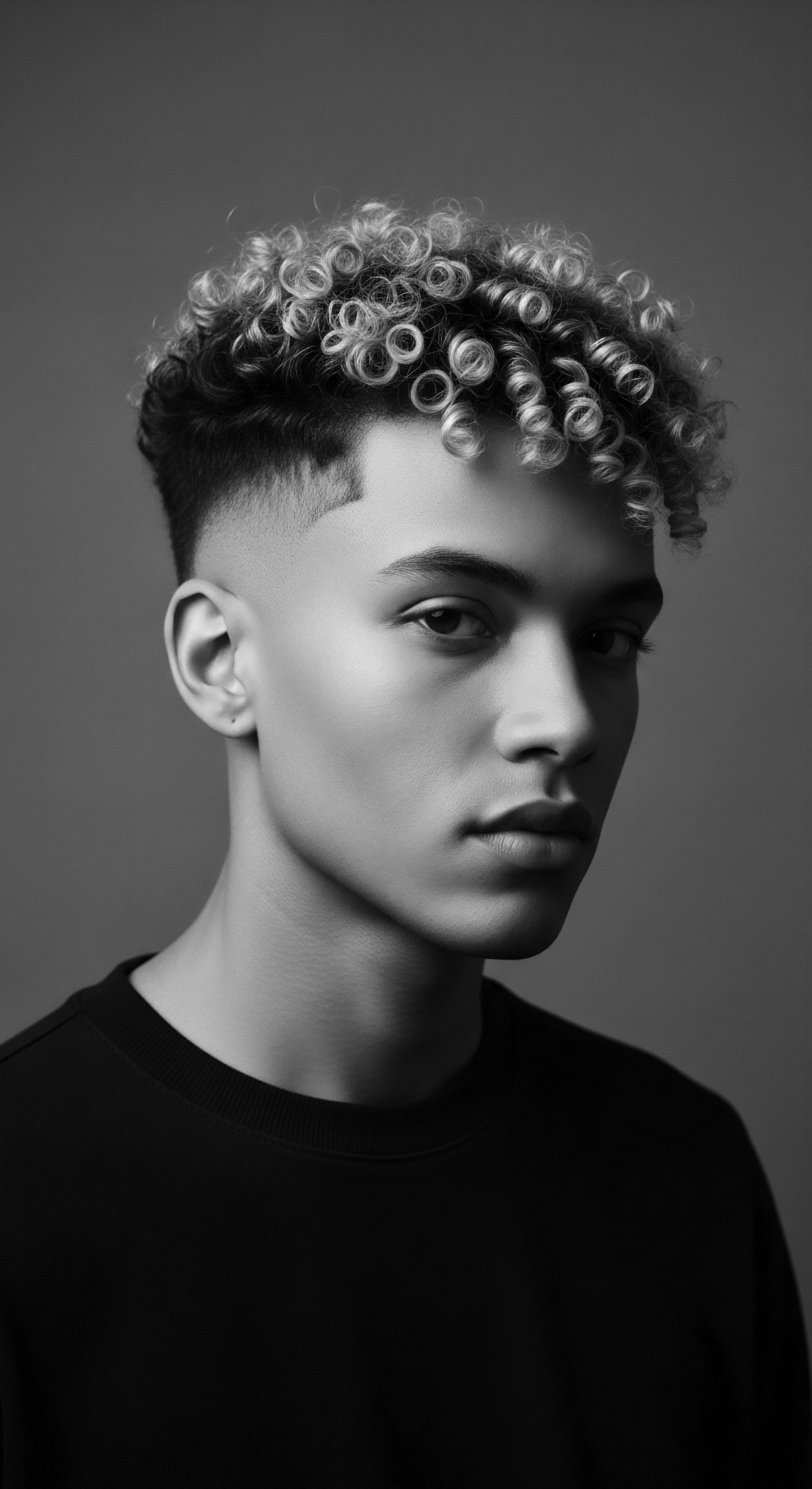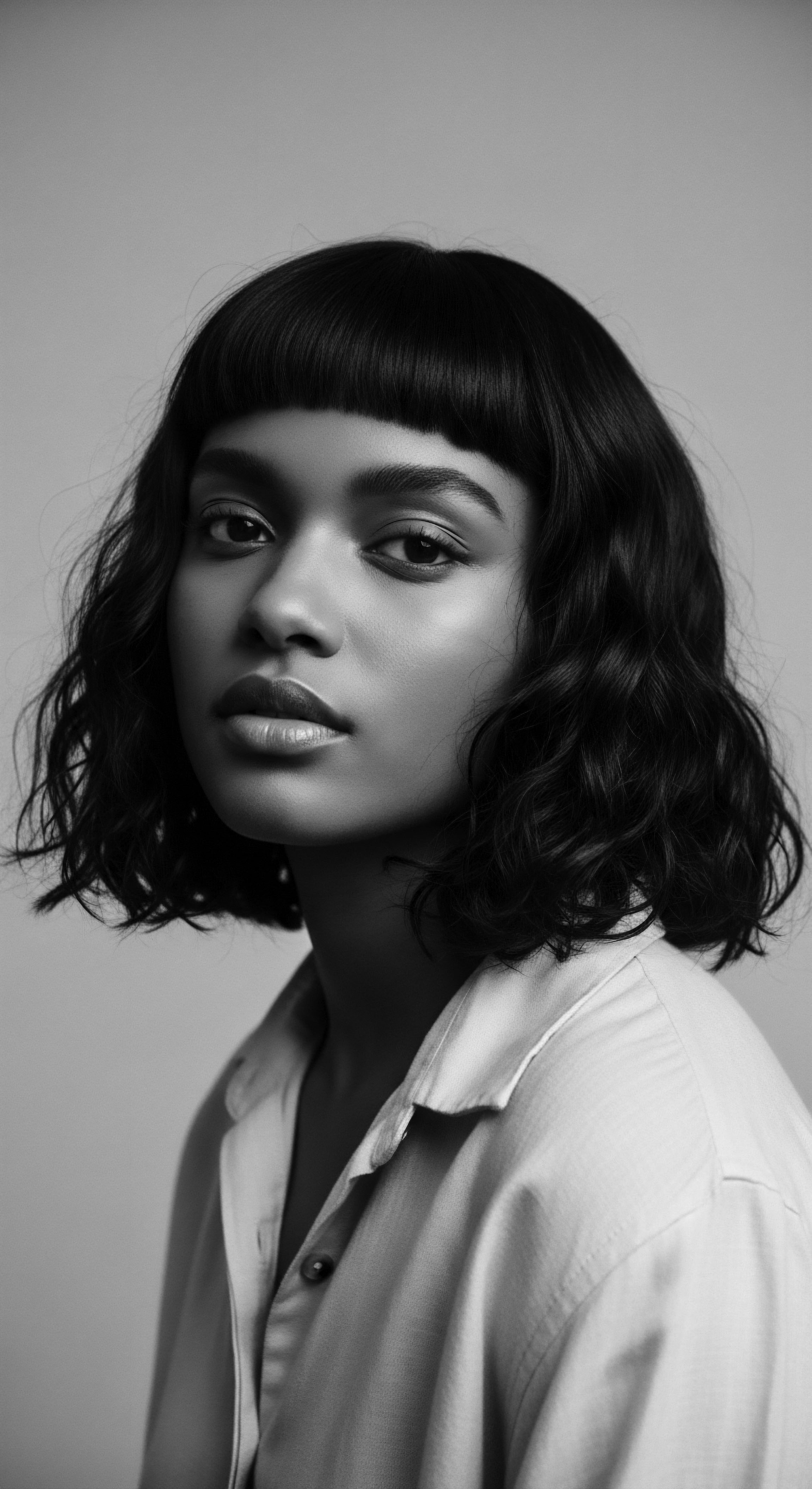
Fundamentals
The concept of Ancient African Hair, as understood within Roothea’s ‘living library,’ transcends a mere historical observation of hair on the African continent. It represents the primordial blueprint of Textured Hair Heritage, a deep wellspring of cultural meaning, ancestral wisdom, and biological resilience. This designation signifies the inherent qualities and diverse expressions of hair that have graced African peoples for millennia, serving as a profound marker of identity, status, and spiritual connection. It is not a static definition but a vibrant, evolving understanding of hair that holds the echoes of countless generations, a foundational element of Black and mixed-race hair experiences across the globe.
Understanding the meaning of Ancient African Hair begins with acknowledging its elemental biology. Afro-textured hair, characterized by its distinct tight curls and coils, evolved as a natural adaptation to the hot, sunny climates prevalent across much of Africa. This unique structure provided crucial insulation, shielding the scalp from the sun’s intense rays while simultaneously aiding in moisture retention within arid environments. Beyond this biological practicality, the explication of Ancient African Hair is inseparable from its role as a dynamic, living canvas for cultural expression and communication.
Ancient African Hair embodies the primal essence of textured hair, a biological marvel interwoven with millennia of profound cultural, social, and spiritual significance.

Early Manifestations and Social Signifiers
In pre-colonial African societies, hair was never simply an aesthetic choice; it was a complex language. The appearance of one’s hair conveyed a wealth of information, from Family Background and Tribal Affiliation to Social Class, Marital Status, Age, and even Religious Beliefs. Hairstyles functioned as visual identifiers, allowing individuals to read narratives about another person’s place within their community. For instance, in West African societies around the 1400s, a person’s hairstyle could reveal their ethnic group, wealth, or even their surname.
- Symbolic Communication ❉ Hair was a non-verbal medium, with specific patterns, adornments, and styles conveying intricate messages about an individual’s life journey or societal role.
- Ritualistic Practices ❉ The act of hair grooming was often a communal and sacred ritual, fostering bonds and passing down ancestral knowledge of care and styling.
- Environmental Adaptation ❉ The coiled nature of Ancient African Hair offered inherent protection against harsh environmental elements, a testament to its evolutionary design.
The delineation of Ancient African Hair also encompasses the tools and materials used in its care. Archaeological findings, particularly from ancient Kush and Kemet (modern-day Sudan and Egypt), reveal the existence of sophisticated hair combs dating back as far as 7,000 years. These early implements, crafted from wood, bone, and ivory, were often adorned with symbolic carvings, underscoring the reverence held for hair and its grooming within these ancient civilizations. Natural elements like clay, oils, herbs, shells, beads, and metal were regularly incorporated into styling and adornment, speaking to a deep connection with the earth and its offerings.

Intermediate
Moving beyond the foundational elements, an intermediate understanding of Ancient African Hair requires a deeper exploration of its dynamic role across diverse African civilizations and its enduring impact on Textured Hair Heritage. This perspective clarifies how ancient practices laid the groundwork for care rituals and cultural expressions that continue to resonate within Black and mixed-race communities globally. The significance of hair in these societies extended into every facet of life, becoming a powerful expression of collective identity and individual narrative.

Cultural Topographies of Hair
Across the vast African continent, the meaning and designation of Ancient African Hair varied, yet a unifying thread of reverence persisted. In ancient Egypt, for example, hair and wigs served as potent symbols of Status, Wealth, and even Divinity. Elite men and women often wore elaborate wigs crafted from human hair, wool, or plant fibers, intricately braided and adorned with precious materials.
The more ornate the coiffure, the higher one’s social standing. This historical example highlights a continuity in the value placed on hair as a social marker, a practice that, though transformed, persists in contemporary textured hair styling.
The historical record shows that hair in ancient Africa was a sophisticated language, speaking volumes about a person’s place in their community and their connection to the spiritual realm.
Beyond Egypt, other ancient civilizations like the Kingdom of Kush (Nubia) also celebrated natural hair textures. Kushite culture emphasized coiled braids and headpieces adorned with jewels, feathers, and metals, reflecting both tribal identity and religious beliefs. Intriguingly, the “Nubian wig,” adopted by figures like Queen Nefertiti during the Amarna period, mimicked the short, curly hair characteristic of Nubian tribespeople, demonstrating cross-cultural exchange and admiration for diverse hair forms. This particular historical instance offers an insight into the fluidity of beauty standards and the appreciation for naturally textured hair, even within royal courts.
The delineation of Ancient African Hair also encompasses its profound spiritual dimension. Many African cultures regarded hair, particularly the crown of the head, as a sacred conduit for Spiritual Energy and a direct link to the divine. This belief elevated hair beyond mere physical adornment, transforming it into a communal asset that connected individuals to their ancestors and the spiritual world.
The Yoruba people of Nigeria, for instance, held hair as the most elevated part of the body, with braided styles sometimes used to send messages to deities. This spiritual significance underscores the deep respect and care traditionally accorded to hair, influencing ancient rituals and practices.

Traditional Hair Care Ingredients and Practices
Ancient African hair care was a sophisticated system, relying on a rich pharmacopoeia of natural ingredients and meticulously developed techniques. These practices were often communal, transforming hair grooming into a social occasion for bonding and sharing knowledge.
- Natural Oils and Butters ❉ Various plant-based oils and butters, such as shea butter and palm oil, were used to moisturize, protect, and add luster to hair. These ingredients provided essential nourishment, guarding against environmental stressors.
- Herbal Infusions ❉ Herbs and botanicals, often specific to regional flora, were brewed into rinses or mixed into pastes to cleanse, strengthen, and promote scalp health. These ancestral remedies were deeply rooted in ethnobotanical wisdom.
- Clays and Pigments ❉ Clays, like red ochre used by the Himba people, served as both protective coatings and cosmetic enhancements, symbolizing connection to the earth and ancestral lands.
- Intricate Braiding and Threading ❉ Techniques like cornrows, box braids, and hair threading (“Irun Kiko” among the Yoruba) were not only stylistic choices but also served as protective measures, minimizing breakage and retaining length. The Yoruba practice of “Irun Kiko,” dating back to at least the 15th century, highlights how threading protected hair from breakage and aided in length retention.
These practices were not merely about appearance; they were about preserving the health and vitality of the hair, ensuring its capacity to serve its many symbolic and functional roles. The knowledge of these ingredients and techniques was passed down through generations, a testament to the enduring heritage of textured hair care.
| Period/Region Ancient Kush & Kemet (Egypt) (7,000+ BCE) |
| Primary Tools Identified Afro Combs (wood, bone, ivory), pins, razors |
| Cultural/Functional Significance Status symbols, ceremonial objects, detangling, styling, spiritual protection. |
| Period/Region Pre-colonial West Africa (15th Century onwards) |
| Primary Tools Identified Combs, pins, razors, natural materials (fibers, shells, beads) |
| Cultural/Functional Significance Facilitated intricate braiding, sectioning, and adornment for social communication. |
| Period/Region Across various ancient African societies |
| Primary Tools Identified Neckrests/Headrests |
| Cultural/Functional Significance Protected elaborate coiffures during sleep, preserved intricate styles, found in grave furniture. |
| Period/Region These tools represent the ingenuity and deep understanding of hair care that existed across ancient African civilizations, preserving heritage through craft. |

Academic
The academic delineation of Ancient African Hair transcends superficial aesthetic appreciation, presenting a rigorous, interdisciplinary examination of its biological, anthropological, and sociological dimensions, deeply rooted in its Textured Hair Heritage. This perspective demands a high level of intellectual inquiry, drawing upon scholarly research to unveil the complex interplay of factors that shaped its meaning and function across diverse African civilizations. The content presented here is not merely an overview; it offers a profound interpretation, clarifying its multifaceted significance through the lens of human studies and expert analysis.

The Unbound Helix ❉ Biocultural Adaptations and Symbolic Complexity
The inherent biological characteristics of what is now termed Afro-textured hair—its distinctive elliptical follicular shape, variable curl patterns ranging from tight coils to broader S-patterns, and a propensity for density—are not random occurrences. Evolutionary biologists propose that these attributes served as critical adaptations to the intense solar radiation and variable humidity of the African continent. The spiraled structure and wider follicular pattern permitted greater air circulation to the scalp, providing thermoregulation, while the dense coiling offered superior UV protection. This biological grounding provides the initial stratum for understanding Ancient African Hair, recognizing it as a product of environmental co-evolution, intrinsically linked to the continent itself.
Yet, the meaning of Ancient African Hair extends far beyond its physiological utility. Anthropological studies consistently highlight hair as a primary site for the inscription of social identity and cultural meaning in pre-colonial African societies. It was a sophisticated semiotic system, capable of communicating intricate details about an individual’s life. Roy Sieber and Frank Herreman, in their seminal work “Hair in African Art and Culture” (2000), meticulously documented how hairstyles defined Leadership Roles, Gender, Ethnic Orientation, Religious Affiliation, and Social Status.
For instance, among the Akan people of Ghana, specific hairstyles could immediately identify a widow, reflecting a profound societal engagement with hair as a visual lexicon of emotional and social states. This intricate relationship between hair and social communication illustrates a level of cultural sophistication where the body itself, particularly the hair, became a living document of communal narratives and individual journeys.
Ancient African Hair is a living archive, where each strand holds the genetic memory of adaptation and the cultural imprint of identity, spirituality, and social order.

Ancestral Practices as Embodied Knowledge Systems
The methods of hair care and styling in ancient Africa were not simply utilitarian; they represented sophisticated systems of embodied knowledge, passed down through generations. These practices were often embedded within communal rituals, transforming grooming into a social act of teaching, bonding, and reinforcing cultural norms. The archaeological discovery of highly refined combs, dating back 7,000 years in Kush and Kemet, alongside preserved hair adorned with intricate beadwork from sites like Kerma in Sudan, provides tangible evidence of a long-standing tradition of meticulous hair artistry. These artifacts are not merely tools; they are historical records of human ingenuity and cultural value placed on hair.
Consider the practice of Hair Threading, known as “Irun Kiko” among the Yoruba people of Nigeria, documented as early as the 15th century. This technique involved wrapping hair sections tightly with thread, often made from natural fibers. Beyond its aesthetic appeal, this method served a critical functional purpose ❉ it stretched the hair, reducing tangles and breakage, thereby aiding in length retention. This specific historical example demonstrates a deep understanding of hair mechanics and protective styling, predating modern scientific validation of such practices.
The meticulousness of these methods underscores an ancestral wisdom that instinctively understood how to maintain the integrity and health of highly textured hair. This is a powerful counter-narrative to later colonial assertions that denigrated African hair as “unruly” or “difficult.”
Furthermore, the spiritual dimension of Ancient African Hair warrants rigorous academic attention. Many African cosmologies held the head as the seat of the soul and the primary point of connection to ancestral spirits and the divine. Consequently, hair, as the most elevated part of the body, was treated with immense reverence. The Yoruba, for instance, believed hair to possess spiritual energy, and certain braided styles were used in rituals to communicate with deities.
This profound spiritual significance informed not only how hair was styled but also how it was protected and adorned, often with amulets or charms believed to offer spiritual safeguarding. The collective consciousness around hair as a sacred entity meant that its care was often performed by respected elders or skilled practitioners, deepening the communal and spiritual bonds within societies.
The scholarly interpretation of Ancient African Hair also encompasses its later politicization during periods of colonialism and the transatlantic slave trade. The forced shaving of African captives’ heads was a deliberate act of dehumanization, a brutal attempt to strip them of their cultural identity and sever their spiritual connections. Despite these oppressive measures, the resilience of textured hair heritage persisted.
Enslaved Africans ingeniously adapted traditional braiding patterns to convey coded messages, such as escape routes, or to conceal rice seeds for survival, transforming hair into a tool of resistance and a repository of ancestral knowledge. This historical trajectory underscores the enduring power of Ancient African Hair as a symbol of defiance and a continuous link to a rich, unyielding heritage, even under the most brutal conditions.
The examination of Ancient African Hair through an academic lens compels us to acknowledge its complexity ❉ it is a biological adaptation, a social signifier, a spiritual conduit, and a testament to cultural resilience. The meticulous practices of hair care, the symbolic language of hairstyles, and the profound spiritual reverence demonstrate a sophisticated understanding of hair that was deeply integrated into the very fabric of ancient African societies. This understanding is not merely historical; it offers profound insights into the enduring significance of textured hair today, grounding contemporary hair experiences in a rich, ancestral past.

Reflection on the Heritage of Ancient African Hair
The journey through the intricate world of Ancient African Hair is a profound meditation on Textured Hair Heritage, an experience that reaches beyond the confines of historical texts and archaeological finds. It is a soulful whisper from the past, a vibrant echo that reminds us of the enduring spirit woven into every coil and curl. This exploration clarifies that hair, particularly textured hair, has always been more than a physical attribute; it is a living archive, a repository of ancestral wisdom, communal narratives, and unyielding resilience. The very definition of Ancient African Hair, as we have seen, is inseparable from the deep cultural, social, and spiritual meanings it held for those who came before us.
The profound significance of this heritage resonates in the present, offering a powerful sense of belonging and continuity for Black and mixed-race individuals. When we consider the purposeful cultivation of protective styles, the reverence for natural ingredients, or the communal rituals of grooming, we are not simply observing history; we are connecting with a legacy of care and self-expression that transcends time. The understanding that our ancestors’ hair was a source of identity, a means of communication, and a sacred link to the divine, provides a potent foundation for celebrating textured hair today. It encourages a shift from external validation to an internal appreciation, recognizing the inherent beauty and strength within each strand.
To understand Ancient African Hair is to unlock a profound connection to a legacy of resilience, wisdom, and intrinsic beauty that continues to shape textured hair experiences.
This journey into the past offers a gentle invitation to honor the inherent capabilities of textured hair, recognizing that its unique structure is a testament to evolutionary brilliance and a canvas for boundless creativity. It beckons us to approach hair care not as a chore, but as a continuation of ancestral practices, a mindful ritual that nourishes not only the physical strands but also the soul. The legacy of Ancient African Hair serves as a guiding light, illuminating a path toward holistic wellness rooted in the wisdom of those who understood that hair is a sacred part of self, deeply connected to community and heritage. It reminds us that our hair carries stories, whispers of triumphs, and the enduring power of a lineage that has always found ways to express its beauty and truth.

References
- Byrd, A. D. & Tharps, L. L. (2002). Hair Story ❉ Untangling the Roots of Black Hair in America. St. Martin’s Press.
- Fletcher, J. (1995). Ancient Egyptian Hair ❉ A Study of the Evidence. Manchester University Press.
- Fletcher, J. & Salamone, F. (2016). An Ancient Egyptian Wig ❉ Construction and Reconstruction. Internet Archaeology, 42.
- Gordon, M. (2000). African Hairstyles ❉ Styles of Yesterday and Today. University of Michigan Press.
- Omotos, A. (2018). The Cultural Significance of Hair in Ancient African Civilizations. Journal of Pan African Studies .
- Sieber, R. & Herreman, F. (Eds.). (2000). Hair in African Art and Culture. Museum for African Art.
- Tharps, L. L. (2001). Hair Story ❉ Untangling the Roots of Black Hair in America. St. Martin’s Press.
- Warner-Lewis, M. (1993). African-Caribbean Hair and Identity. Karia Press.
